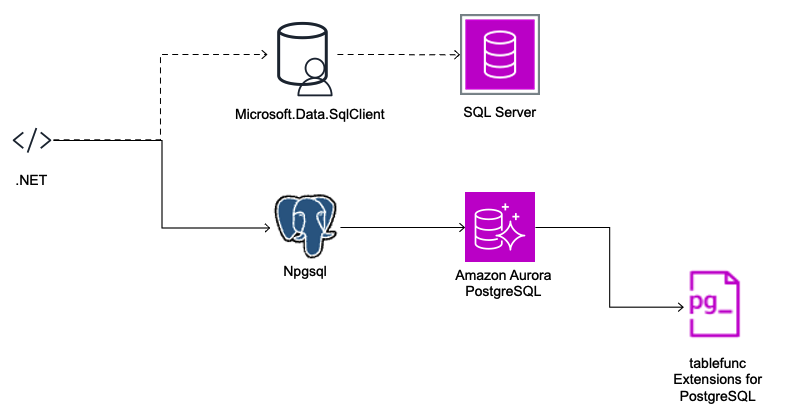When assisting customers with migrating their workloads from SQL Server to PostgreSQL, we often encounter a scenario where the PIVOT function is used extensively for generating dynamic reports.
An existing solution is documented in the Microsoft SQL Server 2019 to Amazon Aurora PostgreSQL Migration Playbook that involves using CASE WHEN statements for each pivoted column. However, this approach has limitations. It becomes difficult to maintain the code when there are many increasing pivoted columns. Additionally, adding a new column requires changes to the source code.
In this post, we show you how to use the crosstab function, provided by PostgreSQL’s tablefunc extension, to implement functionality similar to SQL Server’s PIVOT function, offering greater flexibility.
Solution overview
For this solution, we use crosstab as the foundation to demonstrate the implementation of SQL Server-like PIVOT functionality through the PostgreSQL function get_dynamic_pivot_data. The primary benefit of using crosstab is that it can dynamically generate columns based on the result of the provided queries, making it flexible for different data sets. You will learn how to manage multiple fixed and variable columns in a pivot table, along with the corresponding cursor in the PostgreSQL function. This approach includes handling a PostgreSQL refcursor. The function can be invoked using either psql or C#. psql, a terminal-based front-end to PostgreSQL, will be used to guide you on how to call it with a cursor parameter. Typically, C# accesses PostgreSQL through Npgsql. In this post, we provide sample C# code demonstrating how to use the PostgreSQL function using Npgsql, including the management of a cursor variable.
The following diagram illustrates the solution architecture.

Prerequisites
Configure the following settings in your AWS account and installations on your laptop, based on how you will test the function.
Test on the PostgreSQL client side
The following steps pertain to testing the function on the PostgreSQL client side:
- Provision Amazon Aurora PostgreSQL-Compatible Edition or Amazon Relational Database Service (Amazon RDS) for PostgreSQL.
- Install a PostgreSQL client tool, such as pgAdmin on Amazon EC2 for Microsoft Windows Server, or psql on Amazon Linux 2023.
- AWS CloudShell includes the PostgreSQL client tool (psql) version 15 by default, as shown in the following screenshot. If you prefer not to provision an EC2 instance, you can use CloudShell to access Aurora PostgreSQL directly.

Test with C#:
The following steps pertain to testing with C#. If you don’t want to use C#, these installations aren’t required.
- Download and install .NET SDK 8 on your EC2 instance. The following is an example of how to check the .NET version on Windows:
- Download and install Visual Studio Code on your EC2 instance for Windows.
Use the PIVOT function on the SQL Server side
To transit a pivot query that includes dynamic columns, start by creating two tables and a stored procedure on the SQL Server side. You can find the corresponding code in our Github. Complete the following steps:
- Create two tables with some dummy data
- The following code creates the table QuarterTbl:
The following output shows sample data from the table QuarterTbl:
- The following code creates the table QuarterTbl:
- The following code creates the table ProductSales:
The total sales figures for each quarter across each year are displayed as follows:
The following is the query result for quarterly sales dummy data between 2017-2022.
- In addition to the tables, create a stored procedure called
GetProductSalesReportusing aPIVOTfunction and a dynamic query: - Run the stored procedure with a parameter specifying the list of dynamic columns, to obtain the pivoted results:
The following output shows the results of the pivot query:
Up to this point, you have seen an example of using the PIVOT function to create a sales report in SQL Server. By specifying a dynamic column list, SQL Server can return a result set in a standard table format. Dynamic columns, such as Y20xx, are generated in the moment. In practical scenarios, we have observed customers generating several hundred dynamic columns by querying a primary table.
Transitioning similar logic to PostgreSQL presents a challenge because of its requirement for predefined declarations. In the following section, we show you a workaround for addressing this issue in PostgreSQL.
Implement pivot-like functionality on the PostgreSQL side:
In PostgreSQL, create sample tables identical to those in SQL Server and populate them with the same data. Then, create a function named get_dynamic_pivot_data to implement functionality similar to GetProductSalesReport on the SQL Server side. You can find the corresponding code in our Github.
- Create sample tables in PostgreSQL:
- Populate the two tables in PostgreSQL with the same data as in SQL Server:
- To use the
CROSSTABfunction in PostgreSQL, you must first install and enable the tablefunc extension in your database. This can be done using the following SQL command:Unlike SQL Server’s
PIVOTfunction, which supports multiple row_name columns, PostgreSQL’s crosstab function only supports a single row_name column, as follows:Therefore, you must consolidate all row_name columns into a single composite column, separated by commas. Then, during the creation of the output table, you must unpack all columns from this composite column, as follows:
- Use the function
get_dynamic_pivot_datato create a pivot table containing multiple row_name columns (fixed columns). The function has two parameters: one to hold a cursor using a refcursor data type, and another to hold the dynamic column list using a text data type. To facilitate processing, the code creates a temporary table to contain the intermediate results of the crosstab This function returns the cursor containing the pivot-like query result.
The following code shows the equivalent of the previous SQL Server function in PostgreSQL. Two columns are split from the fixed column, and the rest of the columns (y2017 through y2022) are generated dynamically. It’s important to specify the cursor name (pivot_cur) when invoking the function. You need to run the function within a transaction because data is fetched from a cursor.
Invoke the PostgreSQL pivot-like function from C#:
Complete the following steps to build a sample C# project on Windows. The Npgsql package is required to access PostgreSQL for C#.NET.
- Open a Command Prompt terminal and change to your work directory.
- Create a new .NET project:
- Move into the newly created directory:
- Add Npgsql to the .NET project:
- Add Json support:
- Add AWS SDK:
- Add Secrets Manager Caching:
- Use Visual Studio Code to open the project folder and edit the cs file.
- Run the .NET code in the terminal of Visual Studio Code:
You can review the Program.cs file in the Github repository for details. NpgsqlCommand is used to call the get_dynamic_pivot_data PostgreSQL function, and NpgsqlDataReader is used retrieve the contents of the refcursor.
From a security perspective, both the Aurora PostgreSQL and Windows EC2 instance (hosting the .NET application) are placed in private subnets, with security groups protecting against external attacks. Additionally, database credentials are stored in AWS Secrets Manager, which enhances internal security by managing sensitive information. The purpose of this blog is to demonstrate how to implement SQL Server-like PIVOT queries on Aurora PostgreSQL or Amazon RDS for PostgreSQL. SSL connection implementation is not covered in this sample code as it’s outside the scope of this demonstration.
The following screenshot shows an example of using the Visual Studio Code editor to edit the C# code and run the dotnet command in its terminal. We can see that it produces the same execution result as running the stored function through psql on the command line.

Clean up
Complete the following steps after your testing to prevent unnecessary charges:
- Delete the Aurora PostgreSQL cluster or RDS for PostgreSQL DB instance
- Delete the EC2
Conclusion
In this post, you learned how to use the crosstab function of PostgreSQL with a cursor to achieve similar results to SQL Server’s PIVOT function. Additionally, you learned how to invoke the PostgreSQL function that delivers the pivot functionality using C# code.
Have you used different approaches for implementing PIVOT functionality in PostgreSQL? Share your experiences in the comments section. For more information about migrating from SQL Server to PostgreSQL, see Migrate SQL Server to Amazon Aurora PostgreSQL using best practices and lessons learned from the field.
About the Author
 Jian (Ken) Zhang is a Senior Database Migration Specialist at AWS. He works with AWS customers to provide guidance and technical assistance on migrating commercial databases to AWS open-source databases. In his spare time, he enjoys exploring good restaurants and playing Go, a strategic board game.
Jian (Ken) Zhang is a Senior Database Migration Specialist at AWS. He works with AWS customers to provide guidance and technical assistance on migrating commercial databases to AWS open-source databases. In his spare time, he enjoys exploring good restaurants and playing Go, a strategic board game.
Source: Read More



